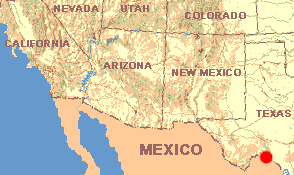 January 1, 1988
January 1, 1988TEXAS: Valverde County
US 377 North Campground in Amistad National Recreation Area 7 miles north of Del Rio
 January 1, 1988
January 1, 1988This story begins on a cold morning with wet wind blowing hard off Amistad Reservoir. Beneath the willow-like trees I bake cornbread in a skillet and scramble eggs with jalapeño peppers while hot tea brews in a cast-iron pot. Wind makes the fire burn too hot. Orange flames sputter, and smoke keeps close to the ground.
With the last cup of tea finished, I discover myself uncertain as to how to begin this project. Finally I just decide to get together some books and my binoculars and walk into the desert, which begins right beside my tent. Very much conscious of, and enjoying, my moment of "starting something big," I begin walking down a wildlife trail among the willow-like trees, my eye fixed on the broad horizon of gray, waist-high scrub before me, almost fearing it.
"Howdy!" greets a sparkly-eyed little man with a bushy, gray beard. This morning he's been standing near his blue, rusted-out van parked across from the toilets. He's the one who last night listened to big-band music on the radio.
"I see you got binoculars, too," he says. "You a birder like me?"
Bill Miles, from Shirland, Illinois, laughs as if he's just heard the world's best joke, just because he's found a fellow birdwatcher. Hearing that today I want to learn the local plants, he leads me to the site next to his, to a run-down aluminum trailer with three large, plastic garbage-bags of squashed beer cans propped against the outside wall, and two yelping pit-bulldogs chained to a post. Here I'm introduced to Bill Stout, a fat, red-faced man of about sixty, mostly toothless and covered with dog hairs. This second Bill, whom I'll now call Dog-Bill, knows his plants so he invites Bird-Bill and me for a walk.
"This gray-leaved shrub that makes up 95% of the vegetation cover around here is called Cenizo," he begins. "The big beer-joint in town is called the Cenizo Inn, you might want to know. Well, the word cenizo in Spanish means 'ash colored,' I reckon. Over here, between your fingers you crush the leaves of this little shrub and tell me what you smell. Smells like medicine, don't it? Well, that's Creosote-bush. Now, here's a little shrub you can make tea out of. It's called Mormon Tea. Its flowers come out in little cone-like things. And here's Allthorn, which really does look like it's no leaves, but "all thorn," hee hee hee, but right after rains, sometimes it has real tiny little leaves that fall off pretty quick. And here's Basket-grass, which the Indians used to make their baskets from... "
Dog-Bill's breeches keep falling down, exposing his red rear-end, but he's so absorbed in his lecture that he doesn't seem to notice or care. Bird-Bill clearly is accustomed to Dog-Bill's manner of doing things.
sotaWalking through the Cenizo, speaking professorially, now Dog-Bill turns to cacti. He shows us the abundant flat-jointed species called Nopal, which Mexicans like to eat. Next comes the Rainbow Cactus and the Nipple Cactus, each about six inches high and oval-shaped, and adorned with short, star-like clusters of spines. Dog-Bill is especially fond of the red-fruited Christmas Cholla, shaped like branched pencils mounted one atop the other, but for me the most interesting species is the one called Horse-cripplerr. It's about eight inches wide, with most of its body buried beneath the ground. Only the broad, low-lying crown of its head is exposed to view, armed with vicious-looking clusters of long, stiff spines that certainly could cripple a horse. Finally Dog-Bill shows us various species of yucca and agave, the most common ones being the Torrey Yucca and the Agave Family member called Sotol. After about three hours of botanizing, the Bills return to camp to rest but I stay in the sea of cenizo. Wanting to fix each of the new plant species in my mind, I plan to take a second look at each one.
However, when I begin moving through the Cenizo, quickly two facts become apparent. First, I can't find the more interesting plants. Second, since I'm not using the paths that Dog-Bill followed (I simply can't find them!) I'm crashing through the brittle scrub tearing my bluejeans, snapping off entire cenizo branches, and generally feeling more than a little inelegant with my scrub-walking.
By dusk I realize that Dog-Bill had been able to so easily find all the rarer things because in this gray sea of stems and leaves he'd memorized the precise location of each interesting plant he'd wanted to show me. He'd given me the impression that in this desert Horse- cripplers, Mormon Tea and Basket-grass are as common as weeds but, at least in the area around the US 377 North Campground, these plants are rare or uncommon.
That night I huddle next to the campfire with Bob, Clay, John and Floyd, and while they tell of epic wars with legendary fish and improbable boat-motors I stare into the orange flames, still feeling the Cenizo pulling at my legs. The thing is, I'm not so much astonished that Dog-Bill could have memorized the exact locations of each of those plants as I am surprised that he so easily, even without trying to do so, created the illusion that several very rare plants were quite common.
What else in this desert -- in this life -- might be more rare -- more precious -- than at first it seems?